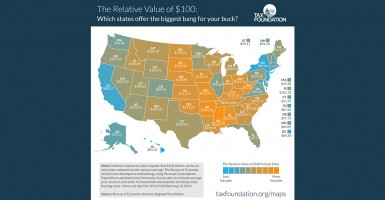How far does $100 get you? According to the Tax Foundation, which monitors tax policy at the federal, state, and local levels, that depends on where you live.
In Tennessee, for example, $100 buys residents what would cost $110.25 in another state where prices are closer to the national average.
“You can think of this as meaning that Tennesseans are about 10 percent richer than their nominal income suggests,” the Tax Foundation reports.
By using data from the U.S. Bureau of Economic Analysis, the nonprofit research organization created a map that reflects the real purchasing power of $100 in each state.
>>> Commentary: You Work This Many Hours a Week to Pay Your Federal Taxes
Folks in the District of Columbia get the least bang for their hundred bucks ($84.60), followed by Hawaii ($85.32), New York ($86.66), New Jersey ($87.64) and California ($88.57).
States where you get the highest purchasing power include Mississippi ($115.74), Arkansas ($114.16), Missouri ($113.51), Alabama (113.51) and South Dakota ($113.38).
>>> Commentary: Needed: A Patriotic Tax Code
In Mississippi, in fact, $100 is worth almost 40 percent more than it is in D.C., where the cost of living is highest.
“The tax policy consequences of this data are significant,” write the Tax Foundation’s Alan Cole, Lyman Stone and Richard Borean:
A poor person in a high cost area – like Brooklyn or Queens – may be artificially boosted out of the range of income where they are eligible for welfare programs, despite still being very poor. At the same time, many people in low-price states may be eligible for welfare programs despite actually being much richer than they appear.
For example: After adjusting for purchasing power, the Tax Foundation found that Kansas has a higher average income than New York. “Adjusting for prices,” the researchers write, “can substantially change our perceptions of which states are truly poor or rich.”























